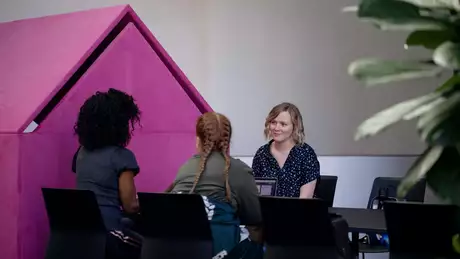New technology and new perspectives on higher education
Published: 11.12.2023 / Publication / Blog
The digital environment in education is changing and educators need to update their competence. In this blog post, I will share some of my experiences and insights from a continuous education course called Open Networked Learning. I will start by explaining what Open Networked Learning is, then I will reflect on the changing teaching practices at the Master’s degree program in Media Management at Arcada, by relating to pedagogical theories such as Community of Inquiry and Digital Literacy, as well as to rising phenomena such as Generative AI, Information Overload and Digital Minimalism.
In autumn 2022 and spring 2023, I updated my pedagogical competence by participating in a continuous education course called Open Networked Learning. The Open Networked Learning education aims to address the changes in university education, particularly the growing demand for online courses that blend synchronous and asynchronous learning. The course is a result of a network of educators and institutions seeking collaboration beyond their universities, both nationally and internationally.
The education is based on online lectures, problem-based learning, and group work online. Reflection, both individually and in groups, is an essential part of the education. The education covers five themes: (1) Online participation and digital literacies, (2) Open learning and sharing, (3) Learning in communities, (4) Design for online and blended learning, and (5) Future practices. Each theme starts with a lecture, but the focus is on working in groups to explore a given scenario, with a high degree of freedom in choosing the focus and area of investigation.
At Arcada University of Applied Sciences we place great importance on pedagogical education. Therefore, most of the topics were familiar to me. However, the course provided a deeper understanding of many theories and concepts, such as problem-based learning, community of inquiry and asynchronous education. The course also gave me time and an opportunity to reflect on my own teaching by utilising these concepts. In addition, we were introduced to a variety of new educational digital tools. These tools seem to appear faster than you can say “blending synchronous and asynchronous learning” and it is indeed a challenge to navigate in this constantly changing digital environment.
For most of us, the concept of learning immediately conjures up images of classrooms, teachers, textbooks, homework etc. Yet, in many cases, the learning that is most personally transformative is often something else. (Wenger, 2009)
As I mainly work with education at the master’s level with students who already have a previous degree and professional experience, my most significant insight was the importance of creating a learning community among students so that they can learn from each other. In this way, my role as an educator becomes more focused on coaching, facilitating, and mentoring, rather than on lecturing and providing information.
In the Master’s Degree programme in Media Management at Arcada University of Applied Science, we emphasise to our students that there is a lot of knowledge among our students. Knowledge does not solely reside with the teacher and learning is not just about listening to what the teacher has to say, or to read the books or articles given by the teacher. Instead, learning is an active collective process where all students can contribute, and indeed they do. For the teacher, this means that it is not so important to convey detailed information that the students receive and memorise. The important thing is instead for the teacher to create a context that enables interaction and exchange of information, which in turn leads the students through creative and analytical thought processes that are meaningful, especially for the students themselves.
So, the teacher’s role is not so much to be a conveyer of information, but more of a coach or a facilitator who creates a context for learning, provides a meaningful framework, tasks, evaluation, and feedback that relates to the students’ pedagogical and professional goals. In many professional areas, the students have more knowledge than the teacher.
The change in the role of the teacher correlates to larger changes in society, media and also in leadership and management. Media is no longer about one-way communication, but about interaction, social media and two-way communication. The same is true regarding leadership. Authoritarian leadership, characterised by individual control over all decisions and little input from group members, is an outdated leadership style, more or less. In our education, we talk about democratic-participatory leadership that actively involves the people being led. Listening, paying true attention to others’ comments, ideas, and feelings, is a core strength for modern leaders. Empathy, understanding and appreciating others’ needs and feelings, is another one.
The changes also relate to an interesting pedagogical theory called Community of Inquiry. Community of Inquiry (COI) is a theory that describes how learning can occur through a shared learning context where participants work together to create knowledge. A COI consists of three forms of presence: social and cognitive presence, as well as teacher presence. Social presence is about creating a sense of community and belonging among participants. This can be achieved through communication, sharing experiences, and building trust. Cognitive presence is about creating a challenging learning environment where participants can think critically, reflect, and build knowledge together. This can be achieved through discussions, reflection, and problem-based learning. Teacher presence is about creating and maintaining a learning environment that supports both social and cognitive presence. Teachers can achieve this by developing course materials, moderating discussions, providing feedback, and encouraging participation. Together, these three elements of COI work to create a learning environment where participants can feel safe, challenged, and supported in their pursuit of knowledge. The COI theory is often used in online and distance education but can also be applied to other learning environments.
Robin Kay (2023), a Canadian professor and dean at Ontario Tech, drawing on COI theory, argues that in online teaching students can only handle traditional lecturing in short slices of 5-10 minutes. After that, some other form of teaching is needed to activate students. This can involve polls, discussions or analytical tasks in smaller groups.
A lecturer can also present parts of his teaching with the help of self-made videos to create variety. The video should not be longer than 2-6 minutes. It is now relatively easy, technically speaking, to create a video even for an amateur. A good rule of thumb, according to Kay, is not to be a perfectionist when making videos. The video can also be used to communicate with students outside of class. One possibility is to create a video that summarises the course content in one minute that students can access before the course begins. Another possibility is to have students make a video introducing themselves to each other at the beginning of a course. Kay also emphasises the importance of using different methods to create a community at the beginning of the course. To do this, it is important how the teacher presents themselves. Kay himself talks about his hobbies and showed pictures of himself skiing with friends and riding a motorcycle, in other words, he presents himself as a person rather than only as a teacher. He also stresses the importance of starting with icebreakers and a clear plan and structure for the course.
Digital literacy refers to the ability to access, understand, evaluate, and use digital information and technology effectively and ethically. It involves having the skills and knowledge to use digital tools and platforms, such as computers, mobile devices, software applications, and social media, to communicate, collaborate, create, and solve problems.
This definition corresponds with the educational aims me and my colleagues had in autumn 2022, when we organised a course on Media technology and Leadership. When planning the course, we struggled regarding what technologies to present. The idea was to stress understanding and evaluation, and not to give instructions on how to use technology. Yet, we also wanted to include some practical elements. So, we introduced Google Trends as an easy-to-use digital analytical tool that can be used to track the development of various new technologies they would themselves have an interest in. We lectured on social research in technology and emerging generative artificial intelligence relating to media technology.
Students got their assignments and some days before they were supposed to present their findings, ChatGPT was introduced and all over the news. That was of course a game-changer and something we have to relate to the next time we organise the course. At the end of the day, we were satisfied with the course and the assignments written by our students. However, in retrospect, especially after the introduction of chatGPT, the written assignments were too information-focused.
While chatGPT can be a valuable tool for university students, it poses major challenges for university education, especially when it comes to essay writing assignments and the evaluation of these. Over-reliance on chatGPT could potentially reduce the quality of independent thinking, and encourage academic dishonesty. It is important for universities to educate students on how to use chatGPT responsibly and ethically, and to stress the importance of independent research and critical thinking skills.
Generative AI such as ChatGPT will have many consequences to our lives and societies (see NVIDIA, 2023), but they will probably add to the increase of information oversupply. However, this is a topic I discussed already ten years ago in a short text for media management students (Nylund, 2013). In the text, I claimed that “The digital media environment is characterised by increased competition, a massive oversupply of content, and a corresponding shortage of receiver attention.” Over the years, many students have read the text. Students have discussed the text in class, and a lot of students seem to think that there is some truthfulness in the line quoted above. But what does it really mean? To start with, there are three claims regarding the digital media environment: (1) There is an increased competition, (2) There is a massive oversupply of content, and (3) a shortage of receiver attention. In what follows, I will dismiss the first claim and discuss the oversupply of content and the shortage of receiver attention. It would be very difficult to measure what would be an oversupply of information in an objective sense, but what we do know is that the amount of information has increased. This is mostly due to the evolution of internet and social media, and, now, the rise of generative AI.
I believe most students relate the claim of oversupply of content and the shortage of receiver attention to their personal experience. I believe it is quite common to feel that there is simply too much information. To have too much information is a stressful situation. Information overload, also known as information anxiety or information stress, is also bad for effective decision-making. The antidote for information overload is of course to reduce the information intake. If you happen to be an information worker, you have to learn to be increasingly selective regarding your information habits.
This is of course easier said than done. We all have developed various information habits and a great deal of the digital content is specifically designed to be addictive. Some people may need assistance and this is exactly what a book called Digital Minimalism, written by Cal Newport (2019), aims to do. Cal Newport is an associate professor of computer science at Georgetown University. He offers in his book a “thirty-day digital declutter”. According to the book, digital minimalism is the key to living a focused life in an increasingly noisy world. So, where do you stand? Do you want more information, or will you join the minimalism movement?
References
Kay, R. (21 November 2023) Design for online and blended learning. Webinar lecture at Open Networked Learning.
Newport, C. (2019) Digital Minimalism: Choosing a Focused Life in a Noisy World. Penguin Random House.
NVIDIA (2023) Generative AI: Revolutionizing the Way Enterprises Work. E-book. https://lore.com/gen-ai-ebook Extern länk
Nylund, M. (2013) Challenges in Media Management. In Karlsson, J & Westerlund, M (eds) BITA’13, Proceedings of Seminar on Current Topics in Business, Information Technology and Analytics, pp. 45-48. Arcada publikation 2/2013. https://www.theseus.fi/bitstream/handle/10024/70463/ArcadaPublikation_2_2013.pdf?sequence=1&isAllowed=y Extern länk
Wenger, E. (2009) A social theory of learning. Routledge.


